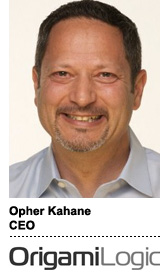 After nine months of testing with beta clients such as Citi, Fox Sports and Visa, marketing intelligence software developer Origami Logic has launched a product that aims to help marketing organizations get a better handle on cross-channel performance.
After nine months of testing with beta clients such as Citi, Fox Sports and Visa, marketing intelligence software developer Origami Logic has launched a product that aims to help marketing organizations get a better handle on cross-channel performance.
At the heart of the technology is a “Marketing Graph” search functionality, designed to let marketers query data quickly to find relationships between campaigns, activities and channel performance that may have otherwise remained hidden in Excel spreadsheets and disparate data flows.
Origami Logic CEO Opher Kahane spoke with AdExchanger about the cross-channel data challenges facing marketers, the importance of search and how a new generation of tools like the one his firm released will change marketer decision-making.
AdExchanger: What root challenges have prevented marketers from harmonizing information from different advertising and social streams into actionable information?
OPHER KAHANE: Marketing data is highly diverse and fragmented across many different channels and “accounts” that belong to the brand, such as multiple Facebook pages, Twitter handles, DoubleClick accounts and so on.
Marketing KPIs need to be customized for specific industry verticals and campaigns rather than solely rely on raw metrics from the underlying marketing platforms. And marketing measurement needs to be “mapped” to the marketer’s business context, including considerations like campaigns, product lines, geographies and strategies.
You’ve described an “Excel spreadsheet problem” faced by marketing departments.
Excel is a symptom of the broader measurement problem marketing departments face today. But a lack of purpose-built marketing measurement tools does drive organizations to use manual, Excel-based measurement and reporting which is resource-intensive, error-prone, lacking in depth and breadth and ultimately takes too long – days to weeks – to complete to have any meaningful impact on the campaign execution and its results.
Why do you believe that search functions are so important for tying together these channels?
We believe that the complexity and diversity of modern marketing data, across both the structured and unstructured aspects of it, make search a very natural way for nontechnical users to ask questions of the data, for both discovery and reporting purposes.
It appears the search functions you’ve developed here are a little different than, say, a blank Google search box. How intuitive is it to use the method of search you’ve developed?
Our search interface has been designed with strong input from our brand customers. It provides a guided search experience, suggesting different types of search elements that might apply to what the user is typing into the search box. This feels a bit more like a “natural language” approach to asking marketing questions of the data. The search terms used are modeled based on how marketers think and operate their marketing efforts, rather than based on the “technical” mechanics of the raw, underlying marketing data gathered from the various marketing execution systems. We built our search interface specifically with marketers in mind, so we feel it’s very intuitive for our users.
How long does it take to train users to use these search functions?
It ranges from a few hours to a day at most to train users on the search function. In general, on-boarding Origami is fairly simple and different users have different level of access.
Do you think report-based metrics are dead entirely, or is there room for report creation beyond just ad hoc searches? And for those so inclined, can they still export data into Excel?
We believe both forms – reporting and ad hoc searches – are required. Brands are using our Marketing Intelligence platform for both: They use the visualization and reporting capabilities for both highly customizable standard reports and dashboards, along with free-form search for ad hoc reporting and discovery. The results of a search could be saved as a report or a visual dashboard which can then be shared across the marketing department for ongoing consumption, automatically updating as more data comes through the system. Plus, Origami allows users to export any of the data into Excel spreadsheets.
How do you think the communication of metrics across marketing silos will change as tools like yours bring together more cross-channel data? How will that affect data-driven marketing?
The impact on marketing organizations can be profound and manifest itself in various ways. Cross-channel campaigns can be executed in a more agile and impactful manner by allowing spend and content to be adjusted and reallocated in flight based on up-to-the-minute cross-channel measurement. This is in contrast with static pre-defined channel allocations.
Timely insights on what works well in certain channels can also be applied to other channels while the campaign is still in flight. For example, if a particular piece of content is doing well on social, the learnings may be applied to the display ads channel. Having a central hub for the data available to all marketers involved in executing and measuring a campaign is essential for a high-impact campaign.
It may also trigger organization structure and process evolution. We believe that over time, tools such as ours will allow marketers to reorganize their team structure and planning process to be campaign- and customer-centric rather than static or channel-centric.
Now that you’ve been through the beta/alpha process and given early feedback, what’s next for your platform?
We will keep innovating in extending both the breadth and depth of our platform. Additionally, we will increasingly infuse automated data science into our platform to accelerate the identification of meaningful and actionable insights, making marketers even more productive. Ideally, we’d like to make tailoring programs on the fly more responsive and intuitive for Origami users.














